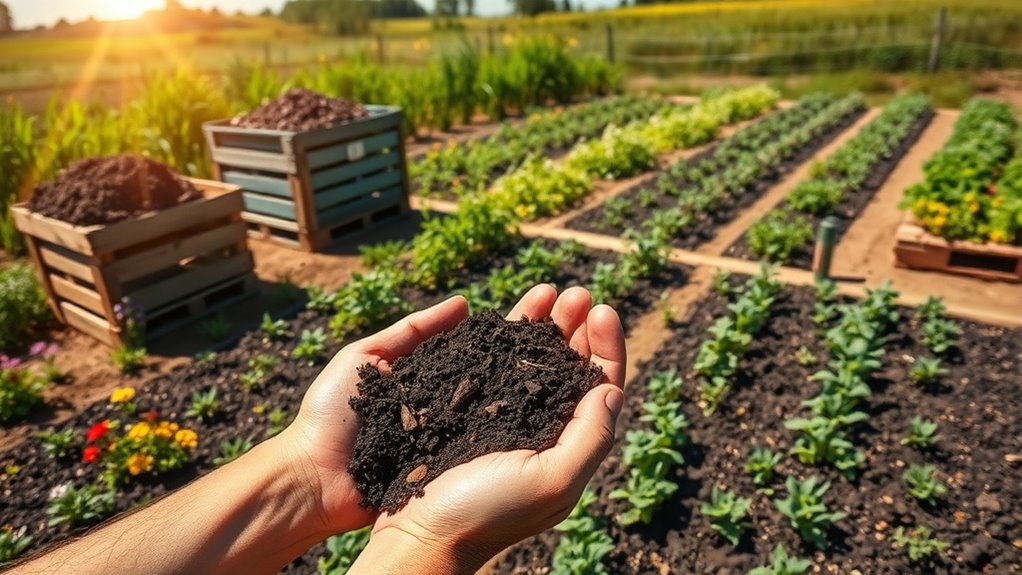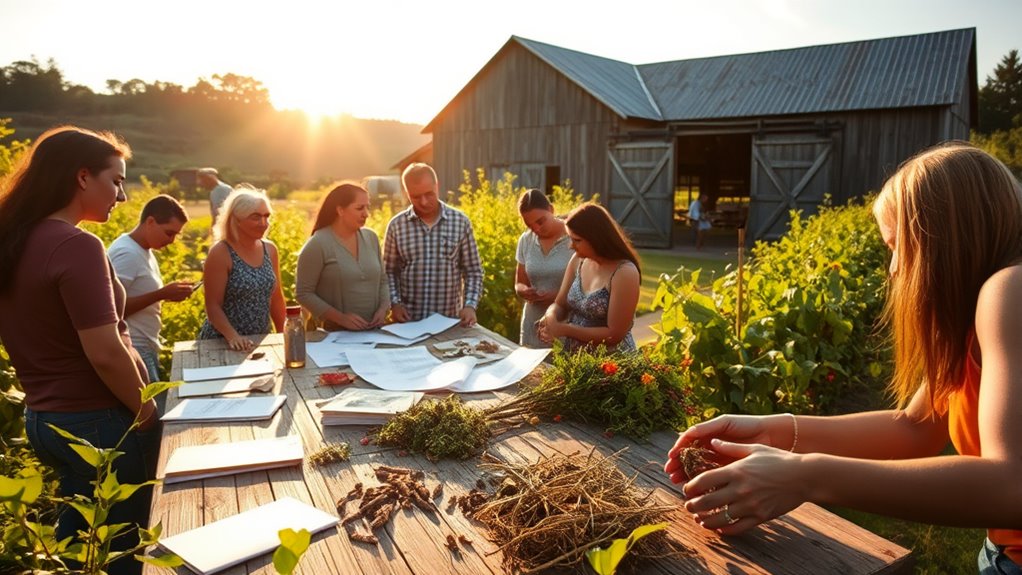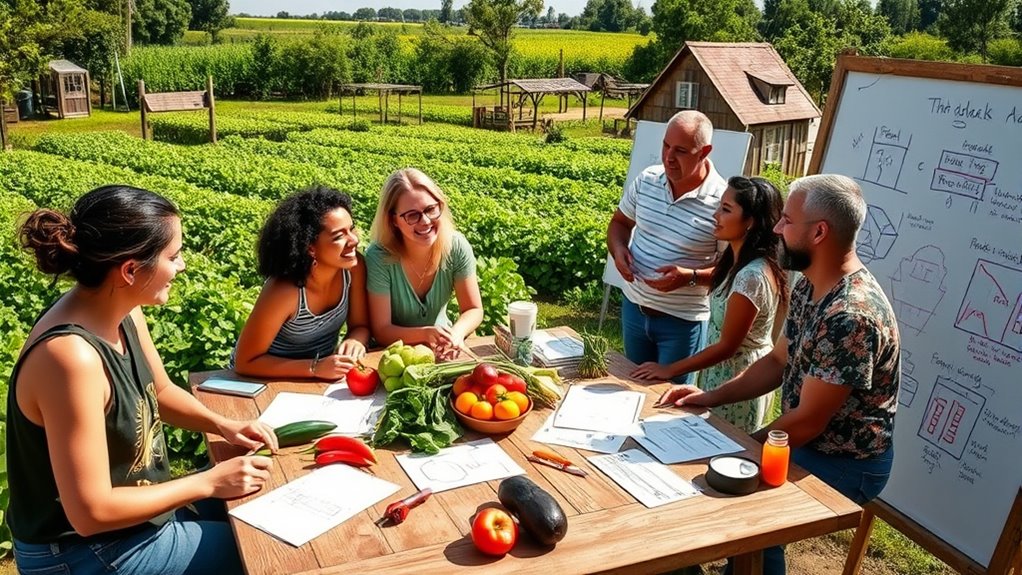To start a farm with no money, assess available land options and consider leasing or urban spaces. Evaluate essential tools and equipment, opting for low-cost or DIY solutions. Leverage your personal skills and engage with the community for support. Identify financial strategies like planting high-yield crops and foraging for wild edibles. Develop a comprehensive business plan tailored to your market. Stay tuned to discover more about networking and continuous education to enhance your farming journey.
Key Takeaways
- Assess available land options through leasing or communal arrangements to minimize costs and maximize resources.
- Utilize essential tools and equipment, focusing on affordable and repurposed solutions to enhance productivity.
- Leverage personal skills and community engagement to build partnerships and share knowledge for mutual benefit.
- Identify low-cost financial strategies such as using natural resources and planting high-yield crops to reduce expenses.
- Conduct market research to determine high-demand crops and develop product strategies aligned with local consumer preferences.
Assessing Available Land Options

When starting a farm with little to no money, assessing available land options is crucial. First, determine how much usable acreage you can access by using tools like the USDA Web Soil Survey.
Next, evaluate the property's location—proximity to markets and agricultural services can save time and resources. Consider leasing land to minimize upfront costs, and explore communal arrangements for shared resources.
Don't overlook unused spaces in urban or rural areas, as they can be valuable for farming. Look into conservation easements that allow long-term farming use.
Finally, investigate public programs offering land access to aspiring farmers. By carefully assessing these options, you can set a solid foundation for your farming venture.
Evaluating Tools and Equipment

Evaluating tools and equipment is vital for starting a farm on a tight budget. Begin by identifying essential tools like a broadfork for soil loosening, a bed preparation rake for efficient soil amendments, and a garden dibber for precise transplanting.
Consider versatile options like a two-wheel tractor and a flail mower for managing crops. You can also repurpose materials, transforming old items like pallets into functional tools or structures.
Don't overlook affordable solutions such as a backpack sprayer for pest control. Prioritize sustainable practices by using organic techniques and natural pest controls like insect nets.
Leveraging Personal Skills

Leveraging your personal skills can be a game-changer in starting a farm with limited funds.
Begin by assessing what skills you already possess—like carpentry or marketing—that can benefit your farming endeavors. Consider enhancing your expertise through courses or apprenticeships, focusing on areas like animal husbandry or financial management.
Once you've honed these skills, apply them creatively to produce value-added products or improve farm operations. Don't forget to share your knowledge with others; this builds valuable partnerships and networks.
Apply your skills creatively to enhance farm operations and foster valuable partnerships by sharing your expertise with others.
As you progress, continuously update your skills to adapt to evolving farming practices. By effectively utilizing what you know, you can significantly cut costs and increase your farm's potential for success.
Engaging With the Community

Engaging with the community is crucial for building a successful farm, especially when funds are tight. Start by understanding the neighborhood's history and challenges, and don't assume what residents want—ask for their input instead.
Forge relationships with local leaders to align your farm goals with community needs. Attend community meetings to grasp concerns and actively address them, showcasing the benefits of urban farming.
Create inclusive opportunities for residents to participate, like volunteer days and workshops. Host events such as open houses and BBQs to foster connections and share stories. Additionally, consider collaborating with local community resources to enhance your farm's sustainability and outreach efforts.
Exploring Resource Sharing Opportunities

Building strong community ties lays the groundwork for exploring resource sharing opportunities that can significantly ease the financial burden of starting a farm.
You can consider land sharing through leasing or communal arrangements, making land more accessible. Equipment pooling enables you to access essential machinery without the hefty price tag.
Collaborating with others on labor can enhance efficiency and lighten your workload. Don't underestimate the power of knowledge exchange; sharing best practices can elevate your farming methods.
Financial partnerships can also reduce costs by sharing expenses. By leveraging these resource-sharing avenues, you'll not only cultivate a support network but also enhance your farming journey, making it more sustainable and manageable.
Implementing Sustainable Farming Practices

As you embark on your farming journey, implementing sustainable practices can't only enhance productivity but also safeguard the environment.
Start by assessing your current practices; choose locally adapted crops that require minimal inputs. Analyze soil health through testing to guide your management decisions.
Evaluate your water use and explore efficient methods like drip irrigation or rainwater harvesting. Consider organic pest control by using natural alternatives instead of chemicals.
Set clear goals for sustainable farming, and implement crop rotation to maintain soil fertility. You might also integrate livestock for a holistic approach.
Lastly, create a timeline for gradually adopting these practices, ensuring a smooth transition to a more sustainable and productive farming operation.
Identifying Financial Strategies

Sustainable farming practices lay a strong foundation, but financial strategies are key to turning your vision into reality.
Start by identifying low-cost equipment options, like buying used tools, sharing with fellow farmers, or exploring DIY solutions. Auction sites and local classifieds often have affordable gear available.
Identify affordable farming equipment by purchasing used tools, sharing resources, or exploring DIY solutions through local classifieds and auction sites.
Leverage natural resources too; rainwater harvesting and solar power can cut costs significantly. Additionally, foraging for wild edibles can provide supplementary food sources and reduce grocery expenses. Understanding emergency preparedness essentials can help you utilize your resources more effectively during times of crisis.
Consider planting hardy and high-yield crops to maximize your output while saving on seeds through seed-saving techniques. For instance, growing broccoli farming tips can help ensure a successful harvest with minimal investment.
Securing free or low-cost land can further reduce expenses, so network for opportunities or explore renting options.
Lastly, building community support through collaborative farming can enhance resource sharing and knowledge exchange, ultimately making your farming journey more sustainable.
Developing a Comprehensive Business Plan

Creating a comprehensive business plan is crucial for your farming success, especially when starting with limited resources. Start with an executive summary that captures your farm's mission, goals, and competitive advantage, making it appealing for potential investors.
Next, provide a business overview detailing your farm's history, key personnel, and operational plans. Your production plan should outline day-to-day activities, resources needed, and sustainable practices.
Define your management structure, including your legal business form and team roles, while detailing hiring strategies. Finally, develop a financial plan with projected income, cash flow forecasts, and funding needs.
This thorough approach helps you clarify your vision and prepare for challenges, positioning you for long-term success.
Conducting Market Research and Product Selection

With a solid business plan in place, the next step is understanding the market to ensure your farm's success. Start by identifying your target market—know where your potential customers are and what they prefer.
Gather secondary data from reports and databases, then conduct primary research through surveys and interviews to collect fresh insights. Analyze competitors to spot trends and pricing strategies that can inform your decisions.
Choose high-demand crops that suit local conditions and assess their production costs. Engage with local markets by visiting farmers' markets and gathering feedback.
Finally, develop product strategies based on your research to align your offerings with consumer preferences. Additionally, consider the importance of estate planning as it can help safeguard your farm's future and ensure its sustainability. This groundwork will position your farm for sustainable success.
Networking and Continuous Education

As you embark on your farming journey, networking and continuous education become essential tools for success. Building relationships with industry stakeholders opens doors to partnerships, resources, and innovative solutions. Additionally, establishing connections with caregiver support networks can provide valuable insights into the needs of local communities and enhance your outreach efforts.
By actively engaging in networking events, you can enhance your visibility and learn from experts about best practices and emerging trends. Continuous education improves your productivity by keeping you updated on the latest techniques, helping you adapt quickly to market changes. Understanding the importance of effective co-parenting communication can also enhance your relationships with fellow farmers, fostering a supportive community.
Engaging in networking events boosts your visibility and equips you with the latest best practices and trends for success.
Utilize digital platforms like LinkedIn and Facebook to establish an online presence, share insights, and connect with other farmers. Remember, collaboration not only reduces costs but also expands your market reach. Additionally, consider the psychological and cognitive benefits of learning from peers, as shared experiences can significantly enhance your farming strategies.
Embrace both networking and education, and you'll cultivate a thriving, sustainable farm.
Frequently Asked Questions
What Are the Best Crops for Beginners With Limited Resources?
If growing food feels like planting dreams, you're in luck!
For beginners with limited resources, crops like peas and green beans are your best friends; they're easy to sow and require little care.
Squash and potatoes thrive with minimal input, while radishes grow quickly.
For fruit, consider strawberries and cucumbers—they're low-maintenance and rewarding.
Embrace these options, and you'll cultivate a thriving garden without breaking the bank!
How Can I Find Free or Low-Cost Farming Workshops?
To find free or low-cost farming workshops, start by checking local community events and agricultural fairs.
Explore online platforms like Class Central for free courses.
Don't overlook local colleges and extension services, which often offer valuable workshops.
Join farmers' markets and agricultural groups to network and learn about upcoming events.
Volunteering at farms can also provide hands-on experience and insights.
Utilize resources like YouTube and podcasts for additional learning opportunities.
What Legal Considerations Should I Know Before Starting a Farm?
Before starting your farm, you've gotta understand key legal considerations.
Choose the right business structure, like an LLC or sole proprietorship, to manage taxes and liability effectively.
Register your business for federal and state tax IDs, and get the necessary licenses and permits based on your location.
Familiarize yourself with zoning and environmental regulations, as well as labor laws, to ensure your farm operates smoothly and legally.
How Do I Price My Products Competitively in Local Markets?
To price your products competitively in local markets, start by researching competitor prices and gathering customer feedback.
Use this information to determine your pricing strategy, whether it's penetration pricing or bundle pricing.
Don't forget to factor in production costs and desired profit margins.
Monitor market trends and adjust your prices as needed.
Finally, ensure you communicate your pricing clearly to build customer trust and encourage sales.
What Are Common Mistakes New Farmers Make and How to Avoid Them?
Did you know that nearly 70% of new farmers face financial difficulties within the first five years?
To avoid common mistakes, create a solid business plan and conduct thorough market research. Set realistic goals and assess risks regularly.
Focus on soil health and efficient water management. Keep meticulous financial records and avoid relying on a single revenue stream.
Stay educated on best practices and adapt to market trends for a successful farming venture.
Conclusion
Starting a farm with no money might sound daunting, but it's entirely possible with resourcefulness and determination. Did you know that nearly 30% of new farmers in the U.S. begin without any financial backing? By leveraging your skills, engaging with your community, and tapping into resource-sharing opportunities, you'll carve your own path. Remember, every successful farm starts with a single seed—so take those first steps and watch your dreams grow!










